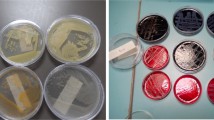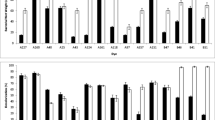Abstract
Congo red (CR) is a genotoxic, sulphonated azo dye and poses significant pollution problem. We hereby report its degradation by Staphylococcus caprae MB400. The bacterium initially propagated as a suspected contaminant upon CR dye supplemented nutrient agar plates, forming zones of clearance around its growth area. The bacterium was purified, gram stained and identified as Staphylococcus caprae via 16S rRNA gene sequencing. Dye decolourization was analysed in liquid culture, and Fourier-transform infrared spectroscopy (FTIR) was conducted for analysis of degraded product/metabolites. A decolourization of ~ 96.0% at 100 µg/ml concentration and pH 7 after 24 h of incubation was observed. Structure of the azoreductase enzyme, responsible for breakage of the bond in the dye and ultimately decolourization, was predicted, and molecular docking was harnessed for understanding the mechanism behind the reduction of azo bond (–N=N–) and conversion to metabolites. Our analysis revealed 12 residues critical for structural interaction of the azoreductase enzyme with this dye. Among these, protein backbone region surrounding four residues, i.e. Lys65, Phe122, Ile166 and Phe169, showed major displacement changes, upon binding with the dye. However, overall the conformational changes were not large.






Similar content being viewed by others
Data availability
All the data used in this manuscript is quoted as accession number or valid identifier and is within the manuscript.
References
Aftab U, Khan MR, Mahfooz M, Ali M, Aslam SH, Rehman A (2011) Decolourization and degradation of textile azo dyes by Corynebacterium sp. isolated from industrial effluent. Pak J Zool 43(1):1–8
Basharat Z, Yasmin A (2022) Sulphonated azo dye decolorization by Alcaligenes faecalis subsp. phenolicus MB207: insights from laboratory and computational analysis. Biophys Chem 286:106806
Basharat Z, Bibi M, Yasmin A (2017) Implications of molecular docking assay for bioremediation. Handbook of research on inventive bioremediation techniques. IGI global, pp 24–45
Basharat Z, Murtaza Z, Siddiqa A, Alnasser SM, Meshal A (2023) Therapeutic target mapping from the genome of Kingella negevensis and biophysical inhibition assessment through PNP synthase binding with traditional medicinal compounds. Mol Divers 1–14
Blümel S, Knackmuss H-J, Stolz A (2002) Molecular cloning and characterization of the gene coding for the aerobic azoreductase from Xenophilus azovorans KF46F. Appl Environ Microbiol 68:3948–3955
Chen K, Huang W, Wu J, Houng L (1999) Microbial decolorization of azo dyes by Proteus mirabilis. J Ind Microbiol Biotechnol 23:686–690
Cheng H-R, Jiang N (2006) Extremely rapid extraction of DNA from bacteria and yeasts. J Microbiol Biotechnol 28:55–59
d’Ersu J, Aubin G, Mercier P, Nicollet P, Bémer P, Corvec S (2016) Characterization of Staphylococcus caprae clinical isolates involved in human bone and joint infections, compared with goat mastitis isolates. J Clin Microbiol 54:106–113
Devriese* L, Poutrel B, Kilpper-Bälz R, Schleifer KH (1983) Staphylococcus gallinarum and Staphylococcus caprae, two new species from animals. Int J Syst Evol Microbiol 33:480–486
Dinçer AR (2020) Increasing BOD5/COD ratio of non-biodegradable compound (reactive black 5) with ozone and catalase enzyme combination. SN Appl Sci 2:736
Erickson K (2010) The jukes-cantor model of molecular evolution. Primus 20:438–445
Eskandari F, Shahnavaz B, Mashreghi M (2019) Optimization of complete RB-5 azo dye decolorization using novel cold-adapted and mesophilic bacterial consortia. J Environ Manag 241:91–98
Feng J, Heinze MT, Xu H, Cerniglia EC, Chen H (2010) Evidence for significantly enhancing reduction of Azo dyes in Escherichia coli by expressed cytoplasmic Azoreductase (AzoA) of Enterococcus faecalis. Protein Pept Lett 17:578–584
Fernando EY, Keshavarz T, Kyazze G (2019) The use of bioelectrochemical systems in environmental remediation of xenobiotics: a review. J Chem Technol Biotechnol 94:2070–2080
Guo G et al (2020) Azo dye decolorization by a halotolerant consortium under microaerophilic conditions. Chemosphere 244:125510
Hernández-Zamora M, Martínez-Jerónimo F (2019) Exposure to the azo dye Direct blue 15 produces toxic effects on microalgae, cladocerans, and zebrafish embryos. Ecotoxicology 28:890–902
John GSM, Rose C, Takeuchi S (2011) Understanding tools and techniques in protein structure prediction. Syst Comput Biol Bioinform Comput Model 185–212
Kanda K et al (1991) Identification of a methicillin-resistant strain of Staphylococcus caprae from a human clinical specimen. Antimicrob Agents Chemother 35:174–176
Katal R, Zare H, Rastegar SO, Mavaddat P, Darzi GN (2014) Removal of dye and chemical oxygen demand (COD) reduction from textile industrial wastewater using hybrid bioreactors. Environ Eng Manag J 13(1):43–50
Kiefer F, Arnold K, Künzli M, Bordoli L, Schwede T (2009) The SWISS-MODEL Repository and associated resources. Nucleic Acids Res 37:D387–D392
Koyani RD, Sanghvi GV, Sharma RK, Rajput KS (2013) Contribution of lignin degrading enzymes in decolourisation and degradation of reactive textile dyes. Int Biodeterior Biodegrad 77:1–9
Krithika A, Gayathri KV, Kumar DT, Doss CGP (2021) Mixed azo dyes degradation by an intracellular azoreductase enzyme from alkaliphilic Bacillus subtilis: a molecular docking study. Arch Microbiol 203:3033–3044
Kumar S, Stecher G, Li M, Knyaz C, Tamura K (2018) MEGA X: molecular evolutionary genetics analysis across computing platforms. Mol Biol Evol 35:1547
Mishra A et al (2023) Decoding whole genome of Anoxybacillus rupiensis TPH1 isolated from Tatapani hot spring, India and giving insight into bioremediation ability of TPH1 via heavy metals and azo dyes. Res Microbiol 174:104027
Morrison JM, John GH (2015) Non-classical azoreductase secretion in Clostridium perfringens in response to sulfonated azo dye exposure. Anaerobe 34:34–43
Naseer A et al (2016) Degradation and detoxification of Navy Blue CBF dye by native bacterial communities: an environmental bioremedial approach. Desalination Water Treatment 57:24070–24082
Oturkar CC, Patole MS, Gawai KR, Madamwar D (2013) Enzyme based cleavage strategy of Bacillus lentus BI377 in response to metabolism of azoic recalcitrant. Bioresour Technol 130:360–365
Pandey A, Singh P, Iyengar L (2007) Bacterial decolorization and degradation of azo dyes. Int Biodeterior Biodegrad 59:73–84
Patel GB, Rakholiya P, Shindhal T, Varjani S, Tabhani N, Shah KR (2021) Lipolytic Nocardiopsis for reduction of pollution load in textile industry effluent and SWISS model for structural study of lipase. Biores Technol 341:125673
Picho-Chillan G et al (2019) Photodegradation of Direct Blue 1 azo dye by polymeric carbon nitride irradiated with accelerated electrons. Mater Chem Phys 237:121878
Rathod J, Dhebar S, Archana G (2017) Efficient approach to enhance whole cell azo dye decolorization by heterologous overexpression of Enterococcus sp. L2 azoreductase (azoA) and Mycobacterium vaccae formate dehydrogenase (fdh) in different bacterial systems. Int Biodeterior Biodegrad 124:91–100
Russ R, Rau J, Stolz A (2000) The function of cytoplasmic flavin reductases in the reduction of azo dyes by bacteria. Appl Environ Microbiol 66:1429–1434
Saratale RG et al (2013) Decolorization and detoxification of sulfonated azo dye CI Remazol Red and textile effluent by isolated Lysinibacillus sp RGS. J Biosci Bioeng 115:658–667
Sarkar S, Banerjee A, Halder U, Biswas R, Bandopadhyay R (2017) Degradation of synthetic azo dyes of textile industry: a sustainable approach using microbial enzymes. Water Conserv Sci Eng 2:121–131
Sarkar S, Banerjee A, Chakraborty N, Soren K, Chakraborty P, Bandopadhyay R (2020) Structural-functional analyses of textile dye degrading azoreductase, laccase and peroxidase: a comparative in silico study. Electron J Biotechnol 43:48–54
Shah MP (2019) Bioremediation of azo dye. Microbial wastewater treatment. Elsevier, pp 103–126
Singh K, Arora S (2011) Removal of synthetic textile dyes from wastewaters: a critical review on present treatment technologies. Crit Rev Environ Sci Technol 41:807–878
Sreelatha S, Velvizhi G, Kumar AN, Mohan SV (2016) Functional behavior of bio-electrochemical treatment system with increasing azo dye concentrations: Synergistic interactions of biocatalyst and electrode assembly. Bioresour Technol 213:11–20
Srinivasan S, Sadasivam SK (2018) Exploring docking and aerobic-microaerophilic biodegradation of textile azo dye by bacterial systems. J Water Process Eng 22:180–191
Suhre K, Sanejouand Y-H (2004) ElNemo: a normal mode web server for protein movement analysis and the generation of templates for molecular replacement. Nucleic Acids Res 32:W610–W614
Suzuki Y, Yoda T, Ruhul A, Sugiura WJ (2001) Molecular cloning and characterization of the gene coding for azoreductase from Bacillus sp. OY1–2 isolated from soil. J Biol Chem 276:9059–9065
Vandenesch F, Eykyn SJ, Bes M, Meugnier H, Fleurette J, Etienne J (1995) Identification and ribotypes of Staphylococcus caprae isolates isolated as human pathogens and from goat milk. J Clin Microbiol 33:888–892
Wei T, Gong J, Jamitzky F, Heckl WM, Stark RW, Rössle SC (2009) Homology modeling of human Toll-like receptors TLR7, 8, and 9 ligand-binding domains. Protein Sci 18:1684–1691
Wilson K (1987) Preparation of genomic DNA from bacteria. Curr Protocols Mol Biol 241–245
Xu F, Mou Z, Geng J, Zhang X, Li C-Z (2016) Azo dye decolorization by a halotolerant exoelectrogenic decolorizer isolated from marine sediment. Chemosphere 158:30–36
Yadav A, Mukherji S, Garg A (2013) Removal of chemical oxygen demand and color from simulated textile wastewater using a combination of chemical/physicochemical processes. Ind Research Eng Chem Res. 52:10063–10071
Yagub MT, Sen TK, Afroze S, Ang HM (2014) Dye and its removal from aqueous solution by adsorption: a review. Adv Colloid Interface Sci 209:172–184
Yang H et al (2019) admetSAR 2.0: web-service for prediction and optimization of chemical ADMET properties. Bioinformatics 35:1067–1069
Yu NY et al (2010) PSORTb 3.0: improved protein subcellular localization prediction with refined localization subcategories and predictive capabilities for all prokaryotes. Bioinformatics 26:1608–1615
Funding
This research received no external funding.
Author information
Authors and Affiliations
Contributions
AY and ZB contributed to conceptualization; ZB was involved in methodology, data curation and writing—original draft preparation, and provided software; SA and ZB contributed to validation and formal analysis; SA was involved in investigation; and AY contributed to resources, writing—review and editing, supervision and project administration. All authors have read and agreed to the published version of the manuscript.
Corresponding authors
Ethics declarations
Conflict of interest
The authors declare no conflict of interest.
Additional information
Communicated by Yusuf Akhter.
Publisher's Note
Springer Nature remains neutral with regard to jurisdictional claims in published maps and institutional affiliations.
Supplementary Information
Below is the link to the electronic supplementary material.
Rights and permissions
Springer Nature or its licensor (e.g. a society or other partner) holds exclusive rights to this article under a publishing agreement with the author(s) or other rightsholder(s); author self-archiving of the accepted manuscript version of this article is solely governed by the terms of such publishing agreement and applicable law.
About this article
Cite this article
Basharat, Z., Asghar, S. & Yasmin, A. Leveraging molecular docking to understand Congo red degradation by Staphylococcus caprae MB400. Arch Microbiol 205, 250 (2023). https://doi.org/10.1007/s00203-023-03591-z
Received:
Revised:
Accepted:
Published:
DOI: https://doi.org/10.1007/s00203-023-03591-z




